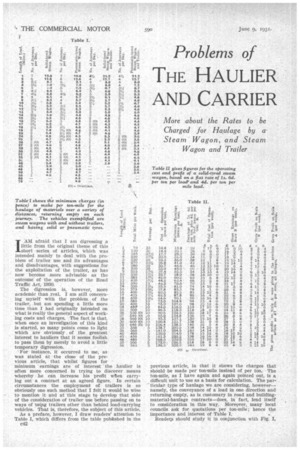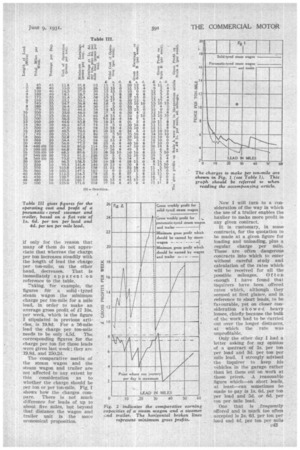Two Novel Bodies of Light Weight
Page 63

Page 64

Page 65

Page 66

If you've noticed an error in this article please click here to report it so we can fix it.
IN the not-far-distant future it will probably be quite common to find that body weights average rather less than half present-day figures. This object will be achieved by the commercial utilization of the scientific progrem made by metallurgists. Examples of what can be done have been given from time to time in this journal. Two most striking instances are to be found in the case of vehicles dispatched recently from the works of the Duramin Engineering Co, Ltd., 23, Hythe Road, London, N.W.10. One was an 8-cubic-yd. tipper, with a body scaling only 13 cwt., and the other a large-capacity Luton. van, the coach
work of which weighed but 10 cwt. '
Dealing first with the larger vehicle, the chassis employed is the well-known A.E.C. Mammoth, equipped with a Eroinilow and Edwards hydraulic gear; the Duramin body is arranged for three-way tipping. Normally, a body of this size would weigh about 2 tons 2 cwt. In consequence of the construction adopted the pay-load is increased by 1 ton 9 cwt. This, in the course of a year, means a considerable increase in revenue-earning ability. The order was obtained on the condition that 1/ ton could be saved, which was calculated to give the operator an additional annual return of £312, or about 175 per cent, on the additional capital outlay.
The body is supported on 13 floor-bearers of channel section, to which the floor, consisting of fin. duralumin plates, is riveted. The bearers are carried by longitudinals of 3-in. by 3-in, by fin, angle, secured above and below 13 bolsters of braced-girder construction. The whole duralumin framing is so designed that the rivets are not in shear, and is such that the body will tip evenly in any direction despite unevenness of the ground.
The uprights carrying the tail and side boards are 3-in. lyv 2-in, by fin, angle, secured to the longitudinal side members. The side boards are -1-16-in. duralumin plate framed and braced by substantial sections of the same metal. The two side boards on each band are so light that they can be lifted simultaneously by one man and secured without assistance. The internal dimensions of the body are 14 ft. by 7 ft. by 2 ft., and the capacity is 8 cubic yds.
To form a lateral tie for the body sides there is a weldless steel tube, equipped with large nuts at the extremities, dropping into sockets in the central uprights. Steel is used for the hinges and locking gear for the sides and tailboard.
The other example has as its basis a Commer G2-type chassis with a long wheelbase, weighing 1 ton 19cwt. The order for the Luton body was received on the condition that the complete vehicle weighed under 21 tons, thus enabling it to take advantage of the 30-m.p.h. speed limit. The internal dimensions of the body are 13 ft. 4 ins, by .6 ft. 10 ins. 1 'AM afraid that I am digressing ,a little from the original theme of this short series of articles, which was intended mainly to •deal with the problem of trailer, use and its advantages and disadvantages, with suggestions for the exploitation of the trailer, as has now become more advisable as the outcome' of the operation of the Road Traffic Act, 1930. ,
The digression is, however, more academic than real, I am still concerning myself with the problem of the trailer, but -am spending a little more time than 1 had originally intended on what is really the general aspect of working costs and charges. Tile fact is that, when once an investlgation of this kjnd is started, so many points come to light which are obviously of the greatest interest to hauliers that it seems foolish to pass them by merely to avoid a little temporary digression.
For instance, it occurred to me, as was stated at the close of the pre vious article, that whilst figures for
minimum earnings are of interest the haulier is often more concerned in trying to discover means whereby he can increase his profit when carrying out a contract at an agreed figure. In certain circumstances the employment of trailers is so obviously one such method that I felt it would be wise
to mention it and at this stage te develop that side of the consideration of trailer use before passing on to ways of using trailers other than behind load-carrying vehicles. That is, therefore, the subject of this article.
As a preface, however, I draw readers' attention to Table I, which differs from the table published in the
c42
previous article, in that it shows the charges that should be made per ton-mile instead of per ton. The ton-mile, as I have again and again pointed out, is a difficult unit to use as a basis for calculation. The particular type of haulage we are considering, however-namely, the conveyance of a' load in one direction and returning empty, as is customary in road and buildingmaterial-haulage contracts-does, in fact, lend itself to consideration in this way. Moreover, many local councils ask for quotations per ton-mile; hence the importance and interest of Table I.
Reader s Should study it in conjunction with Fig.
if only for the reason that many 132, them do not appredate that whereas the charge per ton increases steadily with the length of lead the charge per ton-mile, on the other .decreases. That is immetlitttely apparent "o reference to the table.
'Taking, for example, the 'figures for a solid tyred steam wagon the minimum .charge per ton-mile for a mile lead, in order to make an average gross profit of £7 10s. per week, which is the figure I stipulated in previous articles, is 19.8d. For a 56-mile lead the charge per ton-mile
needs to be only 4.5d. The corresponding figures for the charge per ton for those leads were given last week; they arc 19.8d. and 250.2d.
The comparative merits of the steam wagon and the steam wagon and trailer are not affected to any extent by this consideration as to whether the charge should be per ton or per ton-mile. Fig. I shows how the charges compare. There is not much difference for leads of up to about five miles, but beyond that distance the Wagon and trailer unit is the More economical proposition.
Now I will turn to a consideration of the way in which the use of a trailer enables the haulier to make more profit in any given contract.
It is customary, in some contracts, for the quotation to be made .at a given figure for loading and unloading, pins a regular charge per mile. These are often dangerous contracts into which to enter without careful study and calculation of the rates whichwill be received for all the possible mileages. Otte it enough I have found that inquirers have been offered rates which, although they seemed at first glance, and in reference to short leads, to he favourable, yet on closer consideration showed heavy losses, chiefly because the bulk of the work had to be carried out over the longer distances, at which the rate was unprofitable.
Only the other day I had a letter asking for my opinion of a contract of is. per ton per load and 3d. per ton per mile lead. I strongly advised the inquirer to keep • his vehicles in the garage rather than let them out on work at those prices. A reasonable figure which-on short leads, at least-can sometimes be made to pay is I.e. Od. per ton per load and 5d. or 6d. per ton per mile lead.
One that is frequently offered and is much too often accepted is Is. fid. per ton per load and 4d. per ton per mile lead. I have taken this rate as an example and have cakulated the revenue per mile, gross earnings per week and gross profits per week. In Table II these are sot out in respect of the use of a solid-tyrecl steam wagon and in Table III in regard to a pneumatic-tyred steamer and trailer.
Table II is the more interesting because it approximates more closely to current practice. I would recall • that in the previous calculations I pointed out that £7 10s. per week was the minimum gross profit which should be earned by a steam wagon employed on work of this description. Reference to the column of gross • profits earned under this flat rate of Is. 6d. per ton per load and 4d. per ton per mile serves to show that only six times is the 'profit in excess of that minimum of 17 10s. Most of the time it is below and it falls to as little as £1 19s. 2d. for a 35-mile lead!
This unfortunate condition is more effectively demonstrated in the lower part of Fig. II, where these gross profits are plotted and shown in their relation to a line depicting the minimum of £7 10s. per week. Most of the curve, as may be seen, is well below that line of minimum gross profit.
In• Table III the figures are drawn up in corresponding fashion, and there it is evident that not once does the weekly gross profit fall below the minimum of iS 5s. which I set for a wagon and trailer. The dotted line on Fig. II graphically illustrates this fact and shows, especially if it be considered in relation to the other curves in the same figure, how much more profitable the wagon and trailer can be made in work of this kind. '
In both the curves in Fig. II it is apparent how more regular the profit is over short leads than over long ones. The profit reaches its lowest figure at that point where it becomes just impossible to get in niore than one complete journey per day. In considering these figures the reader should bear in mind one or twcs important matters.
First of all, there is no allowance therein for lost mileage such as that involved' in travelling from the garage to• the point from which the mileage of the lead is measured. That may or may not be considerable. It will be most detrimental when it in sufficient to diminish the number of profit-earning journeys which may be made in a day.
Another point to be considered is the method whereby the mileage is measured. If the basis is to be a radius from some given point, so that the distance is measured in a straight line, further loss may well result from having to make detours. This is sometimes unavoidable and, in cases where a river or railway has to be crossed by a bridge some distance from the point-to-point route, may throw the calculations far out. S.T.R.












































































































